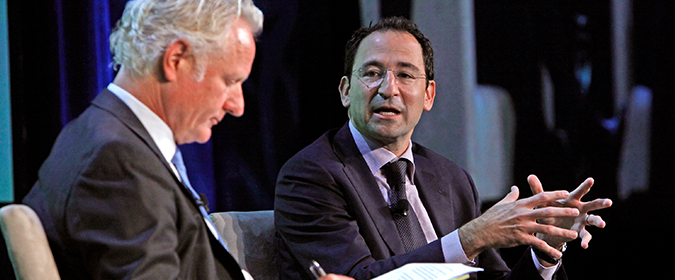Investment strategy, risk and reward were the topics of the morning as industry titan Jon Gray, Global Head of Real Estate and a member of the board of directors of Blackstone, sat down with Dr. Mark Eppli, Ph.D., Professor of Finance and Bell Chair in Real Estate for Marquette University, for an insightful discussion at CRE.Converge 2017 in Chicago.
Since joining Blackstone in 1992, Gray has helped Blackstone build the world’s largest real estate platform with $102 billion in investor capital under management. The company’s portfolio includes hotel, office, retail, industrial and residential properties in the U.S., Europe, Asia and Latin America. Blackstone recently announced a $500 million investment in a major modernization of Chicago’s Willis Tower just two years after buying the U.S.’s second-largest building for a reported $1.3 billion. The company is the largest alternative investment firm globally with over $360 billion in assets under management.
“We have been big bulls on industrial for almost eight years, coming out of the crisis,” said Gray, with increasing pickup because of e-commerce demand in the last three years. “We’ve taken the view that this is a sector with good tailwinds.” As Amazon goes from two-day to two-hour delivery, location becomes critical in meeting the last mile challenge.
“Where are we in the real estate cycle, and what are the risks to disrupt that?” asked Eppli.
“We are in a more mature part of the cycle,” said Gray. “It’s been a long positive cycle so far. Cap rates have fallen pretty significantly and are low by any historical standard. Because of constrained lending, which I think has turned out to be a very good thing, we are still seeing rising occupancy in many sectors, which is positive.” The debt markets are operating in balance, he added.
“It’s a mixed picture,” Gray said, “The conclusion is commercial real estate will continue to increase in value but at a moderate rate.”
“The debt markets aren’t worrying you,” noted Eppli.
“Inflation has been much more constrained than I think any of us would have anticipated,” Gray said, with interest rates likely to be higher down the road than they are currently. “Labor markets are getting tighter and we’re seeing wage pressure that is starting to build up.”
For investments, it’s risky to assume current interest rates and conditions will remain the same going forward. “I do worry there’s a complacency that rates will stay lower forever. At some point as labor markets tighten that will change,” Gray added.
Predicating the impact on investments as a result of national and global events is equally unknown. “If you had a hot war in North Korea that spilled over to South Korea, what does that mean? As an investor, that’s hard to price,” said Gray. “In a world with the kind of volatility we face, how can we protect our assets?” It’s difficult to know what crisis will emerge, so investors need to consider, “Do I have an all-weather portfolio? Can I protect myself no matter what happens? Am I set up in a way that I can insulate myself a bit?”
“How do you maintain discipline within your organization?” asked Eppli.
Early in the cycle, when everything is cheap, investors can cast a wider net, said Gray. As the environment changes, it pays to be more selective and disciplined with investments.
Suburban office is one area that faces challenges, according to Gray. “There are markets with growth, but if you think older Northeast and Midwest cities, it’s about more than rent. In the competition for talent, companies are saying, ‘we want to go where the talent is.’” Lower cost of rent doesn’t necessarily lure companies because there is a cost to recruit and retain high-caliber employees.
At its core, investment is about pattern recognition, Gray concluded; being a consumer of information is the best strategy so you can see trends and shifts where others can’t. For example, predicting the growth of Brooklyn and investing wisely there before everyone else moves in the market, or investing in badly-needed infrastructure improvements across the U.S.
“Sometimes when we make a mistake, we have a hard time admitting it,” Gray said, speaking generally, however “throwing good money after bad is not a smart idea.”
Blackstone’s research and wealth of data can help their teams stay informed in real time of what’s happening and whether it’s wise to deploy more capital in that particular area of not, said Gray. “It’s about being constantly in the flow of your investments and being realistic about what’s happening,” he added.
The discussion closed with the question always on commercial real estate professionals’ minds: What inning are we in the national economy; the real estate market?
Gray’s answer to both: the surprisingly early sixth inning.
 This post is brought to you by JLL, the social media and conference blog sponsor of NAIOP’s CRE.Converge 2017. Learn more about JLL at www.us.jll.com or www.jll.ca.
This post is brought to you by JLL, the social media and conference blog sponsor of NAIOP’s CRE.Converge 2017. Learn more about JLL at www.us.jll.com or www.jll.ca.














